NCERT Solutions for Class 7 Science - Electric Current and its Effects
Q1. Draw in your notebook the symbols to represent the following components of electrical circuits: connecting wires, switch in the ‘OFF’ position, bulb, cell, switch in the ‘ON’ position, and battery.
Ans:
Component of electrical circuit | Symbol |
Connecting wires |  |
Switch in the ‘OFF’ position |  |
Bulb |  |
Cell |  |
Switch in the ‘ON’ position |  |
Battery |  |
Q2. Draw the circuit diagram to represent the circuit shown in figure.
Circuit Diagram
Ans: In the given circuit:
- One terminal of the bulb connects to one terminal of the cell.
- The other terminal of the bulb connects to a safety pin.
- The safety pin is not connected to a drawing pin, making the circuit incomplete.
This means the safety pin acts as a switch in the 'OFF' position. Thus, the circuit diagram can be represented as follows:
 Circuit is not complete
Circuit is not complete
Q3. Figure shows four cells fixed on a board. Draw lines to indicate how you will connect their terminals with wires to make a battery of four cells.
Four Cell fixed on a board
Ans: To create a battery from four cells, follow these steps:
- Connect the negative terminal of the first cell to the positive terminal of the second cell.
- Then, connect the negative terminal of the second cell to the positive terminal of the third cell.
- Next, connect the negative terminal of the third cell to the positive terminal of the fourth cell.
The connections should be made as illustrated below.
Cells are connected with wires
Q4. The bulb in the circuit shown in Figure does not glow. Can you identify the problem? Make necessary changes in the circuit to make the bulb glow.
Bulb in the circuit
Ans:The bulb in the circuit does not glow due to improper connections between the cells. Specifically:
- The positive terminal of one cell is connected to the positive terminal of the other cell.
To make the bulb glow:
- Connect the negative terminal of one cell to the positive terminal of the other cell.
This change ensures a complete circuit, allowing current to flow and the bulb to illuminate.
Negative Terminal connected to Positive Terminal
Q5. Name any two effects of electric current.
Ans: The two effects of electric current are:
- Heating effect: When electric current flows through a wire or conductor, it generates heat. This is evident in appliances like electric heaters and stoves, where electric energy is converted into heat energy, making them hot.
- Magnetic effect: Electric current creates a magnetic field around its path. This principle is utilised in devices such as electromagnets, which can lift objects made of iron or steel. Additionally, electric motors depend on the interaction between electric current and magnetic fields to produce movement.
Q6. When the current is switched on through a wire, a compass needle kept nearby gets deflected from its north-south position. Explain.
Ans: When a current flows through a wire, it generates a magnetic field around it. This causes the compass needle, which is a small magnet, to be affected by the wire's magnetic field. As a result:
- The compass needle gets deflected from its usual north-south alignment.
- This deflection occurs because the wire behaves like a magnet when current passes through it.
- The effect demonstrates the magnetic influence of electric current.
When the current is switched off, the compass needle returns to its original position, indicating that the magnetic effect is directly linked to the flow of current.
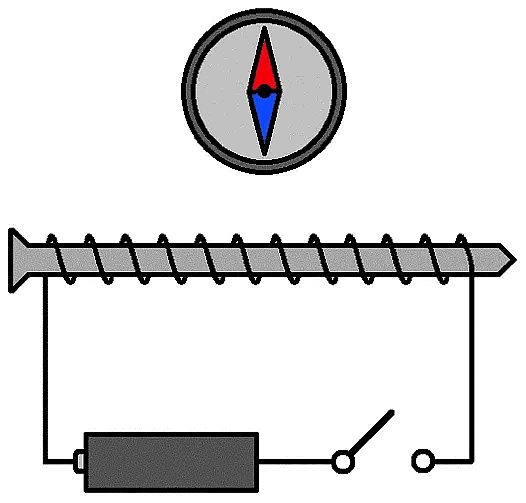 When the switch is closed the compass needle shows deflection
When the switch is closed the compass needle shows deflection
Q7. Will the compass needle show deflection when the switch in the circuit shown by figure is closed?
Ans: No, The given circuit does not have any current source. In the absence of current, the wire does not behave as a magnet and hence, the compass needle will not show any deflection.
Q8. Fill in the blanks:
(a) Longer line in the symbol for cell represents its____terminal.
(b) The combination of two or more cells is called a ____.
(c) When current is switched ‘on’ in a room heater, it ____.
(d) The safety device based on the heating effect of electric current is called a ___.
Ans:
(a) Longer line in the symbol for cell represents its positive terminal.
 View Answer
View Answer 
The symbol for a cell, the longer line represents the positive terminal, while the shorter line represents the negative terminal.

(b) The combination of two or more cells is called a battery.
 View Answer
View Answer 
Cells can be combined to form a Battery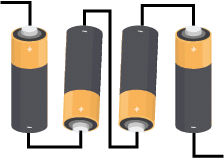 Combined BatteryTo make a battery, the negative terminal of one cell is connected to the positive terminal of the next cell and so on.
Combined BatteryTo make a battery, the negative terminal of one cell is connected to the positive terminal of the next cell and so on.
(c) When current is switched ‘on’ in a room heater, it produces heat.
 View Answer
View Answer 
The working of a room heater is based on the phenomenon of heating effect of electric current.
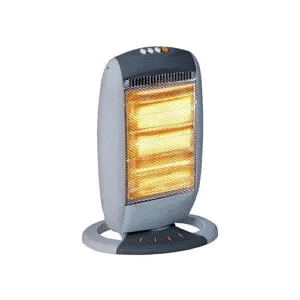 Heater shows the heating effect of electric current
Heater shows the heating effect of electric current
(d) The safety device based on the heating effect of electric current is called a fuse.
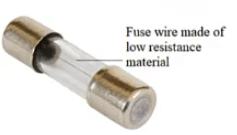
 View Answer
View Answer 
- When the current exceeds its limit the fuse wire shown in the figure melts
- Fuse is a safety device, which limits the current in circuit and breaks the circuit if the current exceeds its maximum limit.
Q9. Mark ‘T’ if the statement is true and ‘F’ if it is false:
(a) To make a battery of two cells, the negative terminal of one cell is connected to the negative terminal of the other cell. (T/F)
(b) When the electric current through the fuse exceeds a certain limit, the fuse wire melts and breaks. (T/F)
(c) An electromagnet does not attract a piece of iron. (T/F)
(d) An electric bell has an electromagnet. (T/F)
Ans:
(a) False
 View Answer
View Answer 
To make a battery of two cells, the negative terminal of one cell must be connected to the positive terminal of the other cell.
(b) True
 View Answer
View Answer 
The wire of the fuse is made of special material which has a low melting point. When large current passes through a fuse, it melts quickly and breaks the circuit.
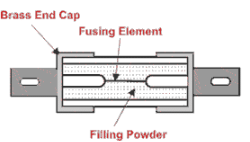 Fusing element shown in figure is a special wire with low melting point
Fusing element shown in figure is a special wire with low melting point
(c) False
 View Answer
View Answer 
Working of an electromagnet is based on the magnetic effect of electric current. An electromagnet behaves as a magnet when current passes through it. Hence, it will attract a piece of iron.
(d) True
 View Answer
View Answer 
An electric bell has a piece of iron wound by a coil. When current passes through this coil, it behaves as an electromagnet.
Electric Bell
Q10. Do you think an electromagnet can be used for separating plastic bags from a garbage heap? Explain.
Ans: No, an electromagnet cannot be used to separate plastic bags from a garbage heap because:
- Electromagnets only attract magnetic materials.
- Plastic bags are non-magnetic and will not be attracted.
- Therefore, an electromagnet is ineffective for this purpose.
Q11. An electrician is carrying out some repairs in your house. He wants to replace a fuse by a piece of wire. Would you agree? Give reasons for your response.
Ans: No, the electrician should not replace the fuse with a piece of wire. This is because:
- A fuse is designed to melt and break when too much current flows through it.
- Not all wires can serve as fuses; they often have a high melting point and won't melt when needed.
- Using a wire instead of a fuse can lead to overheating and potentially cause a fire.
Q12. Zubeda made an electric circuit using a cell holder shown in Fig. a switch and a bulb. When she put the switch in the ‘ON’ position, the bulb did not glow. Help Zubeda in identifying the possible defects in the circuit.
Cell HolderAns: The possible reasons for the bulb not glowing are:
- The connecting wire may be loose.
- The electric cell may be depleted.
- The switch may not be functioning properly.
Q13. In the circuit shown in figure
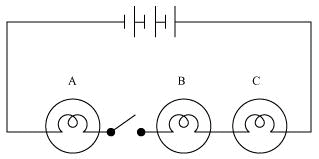
(i) Would any of the bulbs glow when the switch is in the ‘OFF’ position?
(ii) What will be the order in which the bulbs A, B and C will glow when the switch is moved to the ‘ON’ position?
Ans:
(i) No, none of the bulbs will glow when the switch is in the 'OFF' position. This is because the circuit is incomplete, meaning no current flows through it.
(ii) When the switch is moved to the 'ON' position:
- All bulbs A, B, and C will glow simultaneously.
- This occurs because they are all connected to the same battery and switch.
|
112 videos|286 docs|28 tests
|
FAQs on NCERT Solutions for Class 7 Science - Electric Current and its Effects
| 1. What is electric current, and how is it measured? |  |
| 2. What are the effects of electric current on a conductor? |  |
| 3. How does Ohm's Law relate to electric current and resistance? |  |
| 4. What safety precautions should be taken when working with electric current? |  |
| 5. What is the difference between alternating current (AC) and direct current (DC)? |  |






















